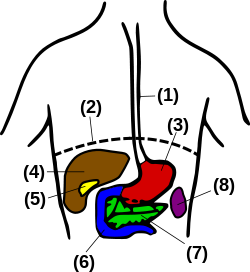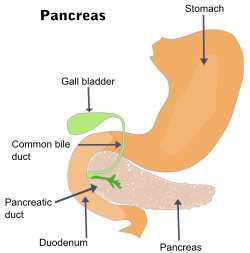Gallbladder
| Gallbladder | |
|---|---|
 |
|
| Gallbladder is #5 | |
 |
|
| Diagram of Stomach | |
| Latin | vesica fellea |
| Gray's | subject #250 1197 |
| System | Digestive system (GI Tract) |
| Artery | Cystic artery |
| Vein | Cystic vein |
| Nerve | Celiac ganglia, vagus[1] |
| Precursor | Foregut |
In vertebrates the gallbladder (cholecyst, gall bladder) is a small organ that aids digestion and stores bile produced by the liver. In humans the loss of the gallbladder is usually easily tolerated.
Contents |
Human anatomy
The gallbladder is a hollow system that sits just beneath the liver.[2] In adults, the gallbladder measures approximately 8 cm in length and 4 cm in diameter when fully distended.[3] It is divided into three sections: fundus, body, and neck. The neck tapers and connects to the biliary tree via the cystic duct, which then joins the common hepatic duct to become the common bile duct.
Microscopic anatomy
The different layers of the gallbladder are as follows:[4]
- The gallbladder has a simple columnar epithelial lining characterized by recesses
Function
The adult human gallbladder stores about 50 millilitres (1.8 imp fl oz; 1.7 US fl oz) of bile, which is released when food containing fat enters the digestive tract, stimulating the secretion of cholecystokinin (CCK). The bile, produced in the liver, emulsifies fats in partly digested food.
After being stored in the gallbladder, the bile becomes more concentrated than when it left the liver, increasing its potency and intensifying its effect on fats.
In other animals
Most vertebrates have gallbladders (exceptions include the horse, deer, and the rat), whereas invertebrates do not. However, its precise form and the arrangement of the bile ducts may vary considerably. In many species, for example, there are several separate ducts running to the intestine, rather than a single common bile duct, as in humans. Several species of mammals and birds lack a gallbladder altogether, as do lampreys.[5]
See also
- Gallbladder disease
- Gallbladder polyp
References
- ↑ Ginsburg, Ph.D., J.N. (2005-08-22). "Control of Gastrointestinal Function". In Thomas M. Nosek, Ph.D.. Gastrointestinal Physiology. Essentials of Human Physiology. Augusta, Georgia, United State: Medical College of Georgia. pp. p. 30. http://www.lib.mcg.edu/edu/eshuphysio/program/section6/6ch2/6ch2line.htm. Retrieved 2007-06-29.
- ↑ http://www.buzzle.com/articles/where-is-the-gallbladder-located-in-the-body.html
- ↑ Jon W. Meilstrup (1994). Imaging Atlas of the Normal Gallbladder and Its Variants. Boca Raton: CRC Press. pp. 4. ISBN 0-8493-4788-2.
- ↑ "Slide 5: Gall Bladder". JayDoc HistoWeb. University of Kansas. http://www.kumc.edu/instruction/medicine/anatomy/histoweb/epithel/epith05.htm. Retrieved 2007-06-29.
- ↑ Romer, Alfred Sherwood; Parsons, Thomas S. (1977). The Vertebrate Body. Philadelphia, PA: Holt-Saunders International. p. 355. ISBN 0-03-910284-X.
External links
- Diagram of Human Stomach and Gallbladder – Human Anatomy Online, MyHealthScore.com.
- www.newchronicles.webs.com/f/gastrointestinalphysiology – Gastrointestinal Physiology Review.
|
||||||||||||||||||||||||||||